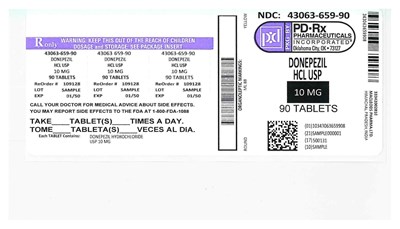Product Images Donepezil Hydrochloride
View Photos of Packaging, Labels & Appearance
Product Label Images
The following 15 images provide visual information about the product associated with Donepezil Hydrochloride NDC 43063-659 by Pd-rx Pharmaceuticals, Inc., such as packaging, labeling, and the appearance of the drug itself. This resource could be helpful for medical professionals, pharmacists, and patients seeking to verify medication information and ensure they have the correct product.
43063659 Label - 43063659

This is a medication information section for Donepezil Hydrochloride tablets. Each tablet has 10 mg of the active ingredient, and the pack contains 90 tablets. This medication is used for the treatment of mild to moderate dementia, such as Alzheimer's disease. Take the tablet(s) as prescribed by your doctor. The label contains important information such as the manufacturer's name, information about the storage, reorder number, lot sample, and expiration date. Side effects might occur, for which you should consult with your doctor or report to the FDA. The rest of the text is not available due to the low quality of the output.*
donepezil figure 1

This appears to be a graph or chart showing the ADAS-Cog (Alzheimer's Disease Assessment Scale - Cognitive) Change from Baseline over time for patients receiving different treatments. The treatments are identified as "Donepezil Hydrochloride 10 mg/day + Ginicai", "Donepezil Hydrochloride 5 mg/day + Dacline", and "Placebo". The y-axis measures the change in ADAS-Cog score, while the x-axis represents the weeks of drug treatment. The graph shows that patients receiving the two Donepezil Hydrochloride treatments had a greater clinical improvement in their ADAS-Cog scores compared to those receiving placebo.*
donepezil figure 11

This appears to be a graph that shows the efficacy of two different doses of Donepezil Hydrochloride (23 mg/day and 10 mg/day) in improving or declining the clinical status of an unknown medical condition over a period of 24 weeks. The graph appears to indicate that both doses of Donepezil Hydrochloride improve clinical outcomes, with the higher dose having a stronger effect.*
donepezil figure 12

This is a graph representing the cumulative percentage of patients undergoing treatment with Donepezil Hydrochloride at 23 mg/day and Donepezil Hydrochloride with no specified dosage. The x-axis shows a range from -60 to 40, with intervals of ten, while the y-axis indicates percentages from 0% to 100%. The graph further shows the SIB change from baseline of the treated patients, with different colors representing the two treatments. No further information is available.*
donepezil figure 13

This is a graph showing the percentage of patients whose CIBIC-plus rating (a measure of cognitive function in Alzheimer's patients) improved, worsened, or remained the same after treatment with either 23 mg/day or 10 mg/day of Donepezil Hydrochloride. The graph also shows the degree of improvement or worsening (markedly, moderately, minimally, or not at all).*
donepezil figure 2

This is a comparison of two groups of patients treated with Donepezil and Placebo for Alzheimer's disease. The chart shows the cumulative percentage of patients in each group based on the change in ADAS-cog score, a measure of cognitive function, with higher scores indicating greater impairment. The treatment group showed a significant improvement with a higher percentage of patients having a decrease in ADAS-cog score compared to the placebo group. The dosage of Donepezil varied between 5mg/day and 10mg/day.*
donepezil figure 3

This appears to be a table or chart related to a medical study or clinical trial involving Alzheimer's disease or dementia. The table shows the number or percentage of patients taking different doses of Donepezil Hydrochloride (either 5mg/day or 10mg/day) or a placebo, along with their corresponding ratings based on the CIBIC-plus scale, which measures levels of improvement or decline in cognitive function. Without additional context or further information, it's difficult to determine the precise meaning or significance of the results.*
donepezil figure 5

This appears to be a graph containing data on the cumulative percentage of patients and their corresponding change in ADAS-cog (a cognitive assessment scale used to measure the severity of Alzheimer's disease). The graph compares the effects of two doses of Donepezil Hydrochloride (5 mg/day and 10 mg/day) with a placebo. The X-axis represents the change from baseline in ADAS-cog score (in points), and the Y-axis represents the cumulative percentage of patients that achieved that score. The graph suggests that both doses of Donepezil Hydrochloride resulted in a greater percentage of patients achieving improvement in ADAS-cog score compared to the placebo, with higher dose resulting in more significant improvement.*
donepezil figure 9

This appears to be a chart comparing the change in ADCS-ADL measurement from baseline of patients who were either given Donepezil Hydrochloride 10mg/day or a placebo for 3 and 6 months. The text does not provide any further information.*
* The product label images have been analyzed using a combination of traditional computing and machine learning techniques. It should be noted that the descriptions provided may not be entirely accurate as they are experimental in nature. Use the information in this page at your own discretion and risk.





